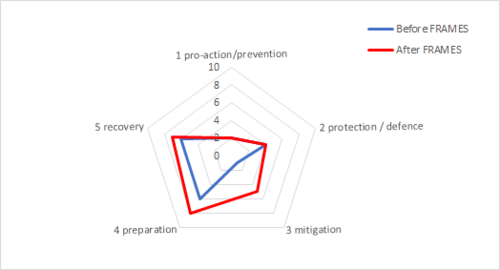LC 00117: verschil tussen versies
Geen bewerkingssamenvatting |
Geen bewerkingssamenvatting |
||
| Regel 9: | Regel 9: | ||
[[Bestand:Web Medway.png|gecentreerd|miniatuur|500x500px]] | [[Bestand:Web Medway.png|gecentreerd|miniatuur|500x500px]] | ||
Desired score to reach per layer in this pilot (Baseline monitor Medway, 2019). | Desired score to reach per layer in this pilot ({{Cite|resource=Bestand:FRAMES Monitoring Survey 14 Medway SERT FINAL.pdf|name=Baseline monitor Medway, 2019|dialog=process-file-dialog}}). | ||
=== Stakeholders involved === | === Stakeholders involved === | ||
Versie van 13 feb 2020 12:00
By looking at the the activities, actors and methods/approaches used, this section will provide a better understanding of the the implementation process of the MLS approach. We will look describe the point of departure, describe who was involved (when, why and how) and what key decisive moments there were.
Point of departure of FRM strategies
The area is dominated by impervious clay soils on the high ground of the ‘High Weald’ which at times of heavy rainfall rapidly drain onto the lower lying land of the Low Weald. The ‘Greensand Ridge’ forms a geomorphological barrier to flow of water to the sea, and has created a large basin to the south of it where many settlements suffer fluvial flood risk, such as the town of Tonbridge and villages such as Yalding. Historically these settlements grew around strategic crossing points of the rivers. The historic core of most of them was constructed on higher ground, however as they expanded due to population growth many properties were built on land prone to flooding.
In addition many smaller communities such as Headcorn and Five Oak Green are at risk of surface flooding from excessive local rainfall events in smaller sub-catchments. Often these communities are at risk from a combination of both fluvial and pluvial flooding, exacerbated with inadequate and outdated drainage infrastructure.
Rapid population growth from the 1920’s to present led to the construction of many newer buildings located in areas of flood risk, and in recent years climate change seems to be contributing to more extreme rainfall events interspersed by longer periods of drought. Local farmers often refer to this as ‘global storming’. The impermeable nature of clay soils means that flooding events can occur even in dry periods, as the soils remain resistant to infiltration in these ‘hard-baked’ conditions. Intensification of agriculture has probably increased the problem due to factors such as the compaction of soils, and a drive in the 20th century to drain the land and straighten rivers in order to increase agricultural production (SERT NFM Project Officer 2019).
Desired score to reach per layer in this pilot (Baseline monitor Medway, 2019).
Stakeholders involved
Role of key actors
Main activities
Referenties
- Transnational Monitor and Evaluation report FRAMES, FRAMES, FRAMES, 8 juni 2020.
- FRAMES Monitoring survey 14 Medway, SERT and Environment Agency UK, SERT, 11 februari 12019.

